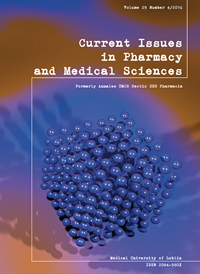The use of a freeze-dried extract of Ligusticum mutellina in a cosmetic cream with potential antioxidant properties
DOI:
https://doi.org/10.1515/cipms-2016-0032Keywords:
cosmetic formulation, phenolic acids, antioxidant propertiesAbstract
The aim of this work was to develop a cream formulation with potential antioxidant properties. Herein, a freeze-dried extract of Ligusticum mutellina was used as a source of active compounds. The proposed qualitative composition of the cream was characterized by a good polyphenolic compounds release profile. Of note, the highest R2adj values were obtained for the Korsmeyer-Peppas and Higuchi models (0.9159 and 0.9226, respectively). These results indicate that a freeze-dried extract of L. mutellina, due to its retained high phenolic acids content, could become a key component in antioxidant creams.
References
1. Chladek W. (2008). Biomechanika inżynierska narządu żucia. Zagadnienia wybrane. Gliwice: Wyd. Pol. Śl.; p. 169.
2. Faria A.C.L. et al.: Wear resistance of experimental titanium alloys for dental applications. J. Mech. Behav. Biomed. Mater., 4, 1873, 2011.
3. Iijima D. et al.: Wear properties of Ti and Ti-6Al-7Nb castings for dental prostheses. Biomaterials, 24, 1519, 2003.
4. Jałbrzykowski M. et al.: Aspects of exploitation stability of selected dental prosthetic bridges. Acta Mech. Autom., 5, 54, 2011.
5. Li-Juan X. et al.: Microstructure and dry wear properties of Ti-Nb alloys for dental prostheses. Trans. Nonferrous Met. Soc. China, 19, 639, 2009.
6. Lin H.-Y. et al.: Metallurgical, surface, and corrosion analysis of Ni-Cr dental casting alloys before and after porcelain firing. Dent. Mater., 24, 378, 2008.
7. Long M., Rack H.J.: Friction and surface behavior of selected titanium alloys during reciprocating-sliding motion. Wear, 249, 158, 2001.
8. Milewski G. (2002). Wytrzymałościowe aspekty interakcji biomechanicznej tkanka twarda – implant w stomatologii. Kraków: Zeszyty Naukowe Politechniki Krakowskiej, seria Mechanika; p. 89.
9. Nine M.J. et al.: Wear Debris Characterization and Corresponding Biological Response: Artificial Hip and Knee Joints. Materials, 7, 980 2014.
10. PN-EN ISO 10271: 2012. Stomatologia – Metody badania korozji materiałów metalowych.
11. Rocha L.A., Oliveira F., Cruz H.V., Sukotjo C., Mathew M.T. (2013). Bio-tribocorrosion in dental applications. Chapter in a book: Yan Y. (editor) Bio-Tribocorrosion in Biomaterials and Medical Implants. Cambridge: Woodhead Publishing Limited; pp. 223-249
12. Souza J.C.M. et al.: Simultaneous degradation by corrosion and wear of titanium in artificial saliva containing fluorides. Wear, 292-293, 82, 2012.
13. Strietzel R.: Ponowne odlewanie stopów dentystycznych. Dent. Labor.,4, 3, 2000.
14. Vieira A.C. et al.: Influence of pH and corrosion inhibitors on the tribocorrosion of titanium in artificial saliva. Wear, 261, 994, 2006.
15. Walczak M. (2014). Influence of the selected technological processes on durability of metal-ceramic systems used in dental prosthetics. Lublin: Published by Lublin University of Technology; p. 183.
16. Walczak M., Pieniak D., Niewczas A.M.: Effect of recasting on the useful properties CoCrMoW alloy. Eksploatacja i Niezawodność – Maintenance and Reliability, 16, 330, 2014.
17. Walczak M., Różycki Ł.: Analiza naprężeń w twardych tkankach zębów na przykładzie dolnego siekacza z wykorzystaniem metody MES. Postępy Nauki i Techniki, 11, 107, 2011.
18. Wang L. et al.: Friction and wear behaviors of dental ceramics against natural tooth enamel. J. Eur. Ceram., 32, 2599, 2012.
19. Wataha J.C. et al.: Brushing-induced surface roughness of nickel-, palladium-, and gold-based dental casting alloys. J. Prosthet. Dent.,99, 455, 2008.
20. Żmudzki J. (2012). Uwarunkowania materiałowe wydolności czynnościowej całkowitych osiadających protez zębowych [Online]. Open Access Library: http://www.openaccesslibrary.com/vol10/4.pdf [2016, May 12].
Downloads
Published
Issue
Section
License
Copyright (c) 2017 Authors

This work is licensed under a Creative Commons Attribution-NonCommercial-NoDerivatives 3.0 Unported License.


